flat tire TOYOTA SEQUOIA 2010 2.G Owners Manual
[x] Cancel search | Manufacturer: TOYOTA, Model Year: 2010, Model line: SEQUOIA, Model: TOYOTA SEQUOIA 2010 2.GPages: 660, PDF Size: 12.29 MB
Page 1 of 660
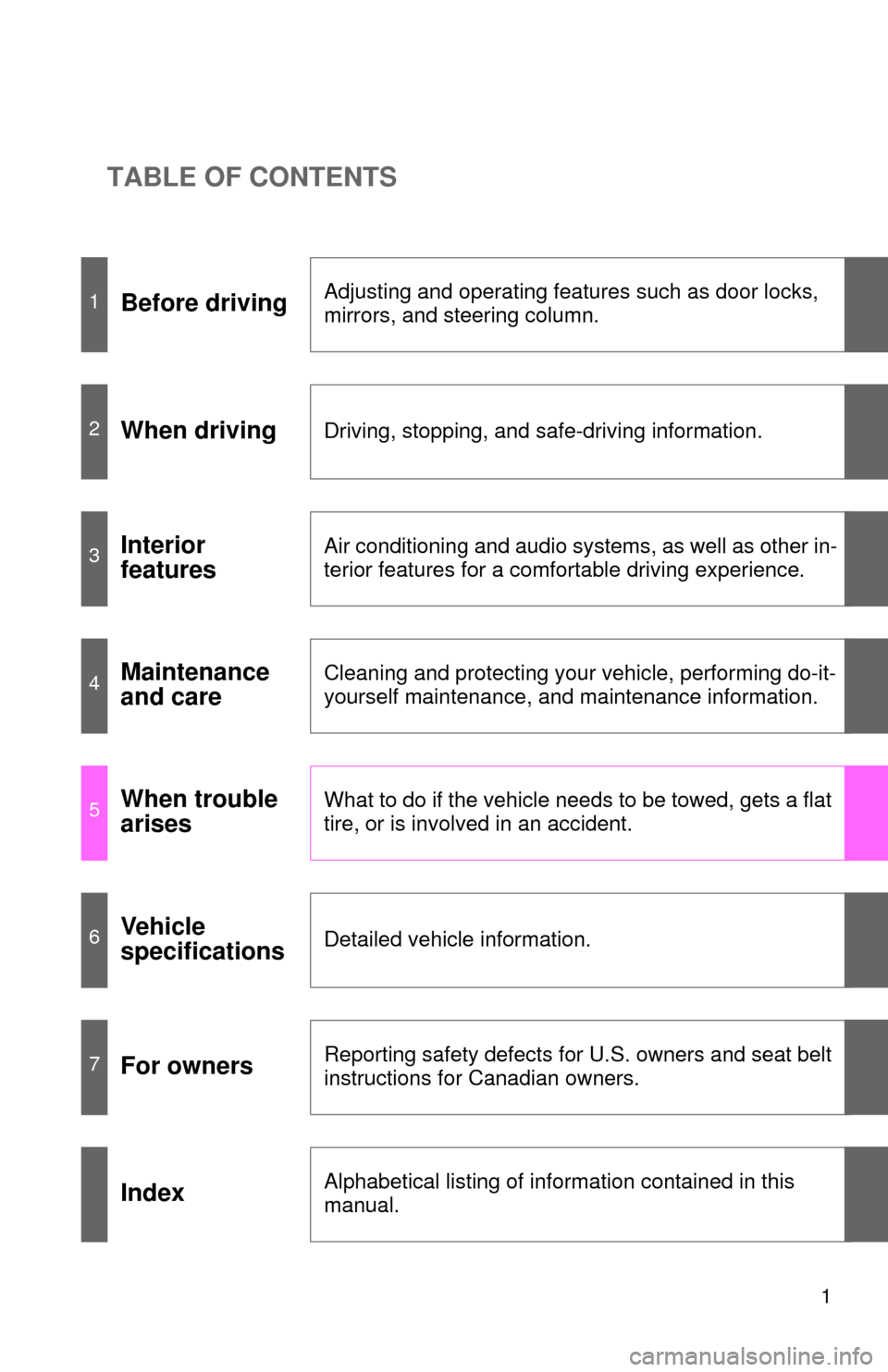
TABLE OF CONTENTS
1
1Before drivingAdjusting and operating features such as door locks,
mirrors, and steering column.
2When drivingDriving, stopping, and safe-driving information.
3Interior
featuresAir conditioning and audio systems, as well as other in-
terior features for a comfortable driving experience.
4Maintenance
and careCleaning and protecting your vehicle, performing do-it-
yourself maintenance, and maintenance information.
5When trouble
arisesWhat to do if the vehicle needs to be towed, gets a flat
tire, or is involved in an accident.
6Vehicle
specificationsDetailed vehicle information.
7For ownersReporting safety defects for U.S. owners and seat belt
instructions for Canadian owners.
IndexAlphabetical listing of information contained in this
manual.
Page 5 of 660
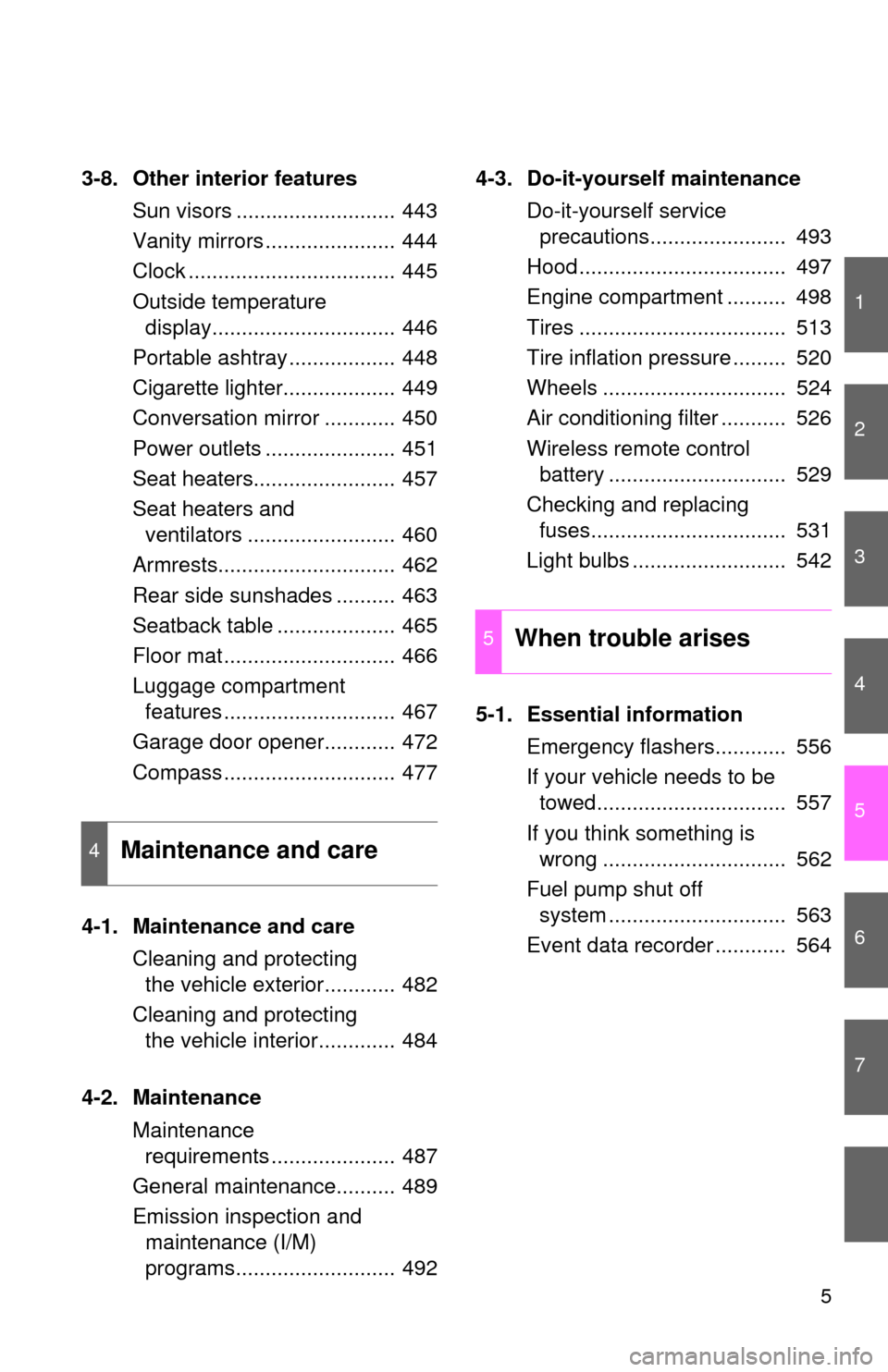
1
2
3
4
5
6
7
5
3-8. Other interior featuresSun visors ........................... 443
Vanity mirrors ...................... 444
Clock ................................... 445
Outside temperature display............................... 446
Portable ashtray .................. 448
Cigarette lighter................... 449
Conversation mirror ............ 450
Power outlets ...................... 451
Seat heaters........................ 457
Seat heaters and ventilators ......................... 460
Armrests.............................. 462
Rear side sunshades .......... 463
Seatback table .................... 465
Floor mat ............................. 466
Luggage compartment features ............................. 467
Garage door opener............ 472
Compass ............................. 477
4-1. Maintenance and care Cleaning and protecting the vehicle exterior............ 482
Cleaning and protecting the vehicle interior............. 484
4-2. Maintenance Maintenance requirements ..................... 487
General maintenance.......... 489
Emission inspection and maintenance (I/M)
programs........................... 492 4-3. Do-it-yourself maintenance
Do-it-yourself service precautions....................... 493
Hood ................................... 497
Engine compartment .......... 498
Tires ................................... 513
Tire inflation pressure ......... 520
Wheels ............................... 524
Air conditioning filter ........... 526
Wireless remote control battery .............................. 529
Checking and replacing fuses................................. 531
Light bulbs .......................... 542
5-1. Essential information Emergency flashers............ 556
If your vehicle needs to be towed................................ 557
If you think something is wrong ............................... 562
Fuel pump shut off system .............................. 563
Event data recorder ............ 564
4Maintenance and care
5When trouble arises
Page 6 of 660

TABLE OF CONTENTSIndex
6
5-2. Steps to take in an emergencyIf a warning light turns on or a warning buzzer
sounds... .......................... 566
If a warning message is displayed (vehicles
with multi-information
display) ............................. 575
If you have a flat tire ........... 580
If the engine will not start ... 591
If the shift lever cannot be shifted from P ................... 593
If you lose your keys .......... 594
If the vehicle battery is discharged ....................... 595
If your vehicle overheats .... 598
If the vehicle becomes stuck................................. 601
6-1. Specifications Maintenance data (fuel, oil level, etc.) ........... 604
Fuel information ................. 617
Tire information .................. 621
6-2. Customization Customizable features ....... 632
Items to initialize................. 636 Reporting safety defects
for U.S. owners ................. 638
Seat belt instructions for Canadian owners
(in French) ........................ 639
Abbreviation list ........................ 644
Alphabetical index .................... 646
What to do if... ........................... 654
6Vehicle specifications
7For owners
Index
Page 9 of 660
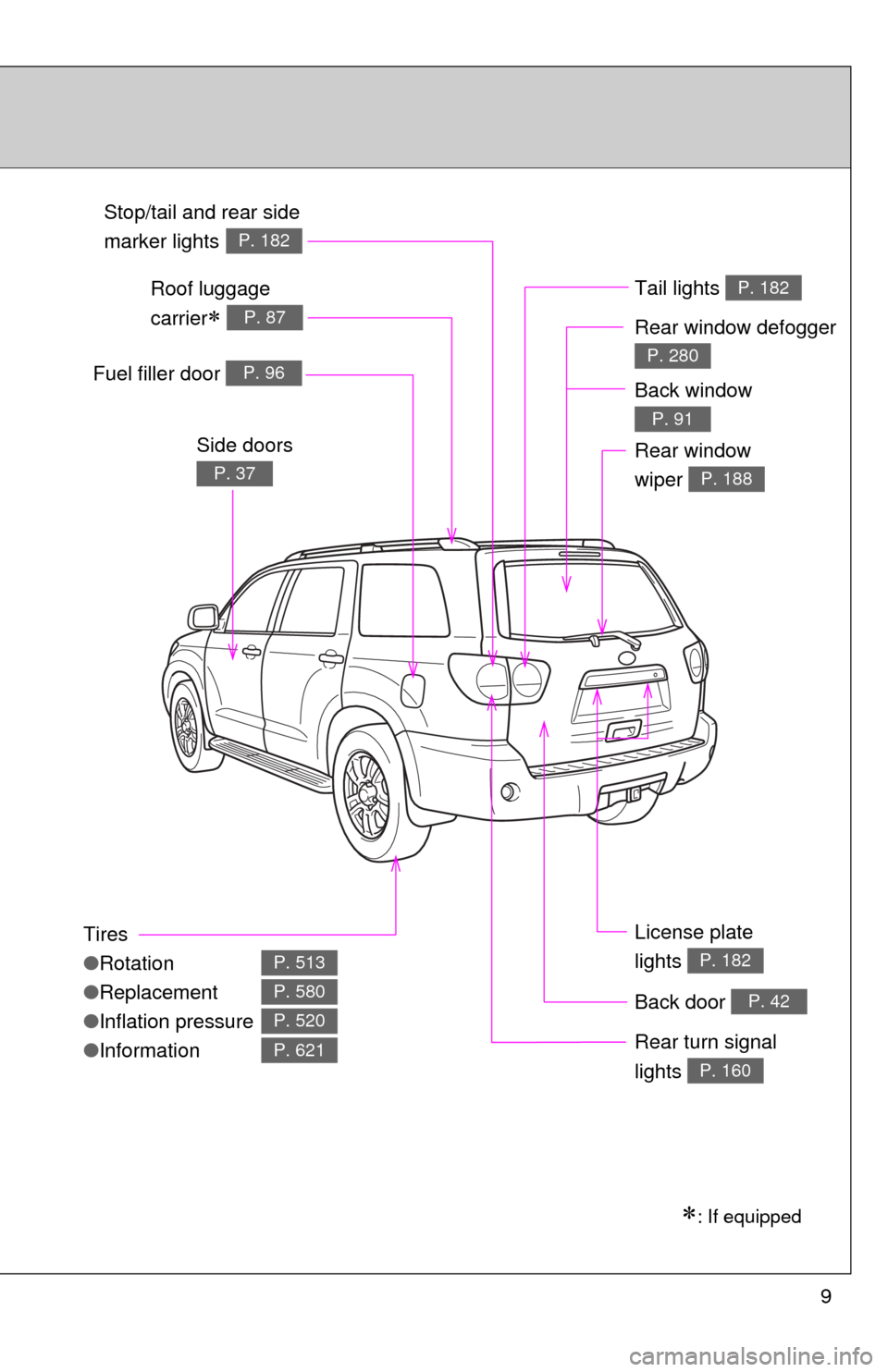
9
Tires
●Rotation
● Replacement
● Inflation pressure
● Information
P. 513
P. 580
P. 520
P. 621
Fuel filler door P. 96
Rear turn signal
lights
P. 160
Stop/tail and rear side
marker lights
P. 182
Side doors
P. 37
: If equipped
Back door P. 42
License plate
lights
P. 182
Tail lights P. 182
Rear window defogger
P. 280
Rear window
wiper
P. 188
Roof luggage
carrier
P. 87
Back window
P. 91
Page 152 of 660

152 2-1. Driving procedures
NOTICE
■If you hear a squealing or scrapin g noise while driving (brake pad wear
limit indicators)
Have the brake pads checked and replaced by your Toyota dealer as soon
as possible.
The rotor damage can result if the pads are not replaced when needed.
It is dangerous to drive the vehicle when the wear limits of the brake pads
and/or that of the brake discs are exceeded.
■ If you get a flat tire while driving
A flat or damaged tire may cause the following situations. Hold the steering
wheel firmly and gradually press the brake pedal to slow down the vehicle.
●It may be difficult to control your vehicle.
● The vehicle will make abnormal sounds.
● The vehicle will behave abnormally.
● Replace a flat tire with a new one. ( P. 580)
■ When encountering flooded roads
Do not drive on a road that has flooded after heavy rain etc. Doing so may
cause the following serious damage to the vehicle.
●Engine stalling
● Short in electrical components
● Engine damage caused by water immersion
In the event that you drive on a flooded road and the vehicle is flooded, be
sure to have your Toyota dealer check the following.
● Brake function
● Changes in quantity and quality of oil and fluid used for the engine, trans-
mission, transfer (4WD models), differentials, etc.
● Lubricant condition for the propeller shaft, bearings and suspension joints
(where possible) and the function of all joints, bearings, etc.
Page 219 of 660
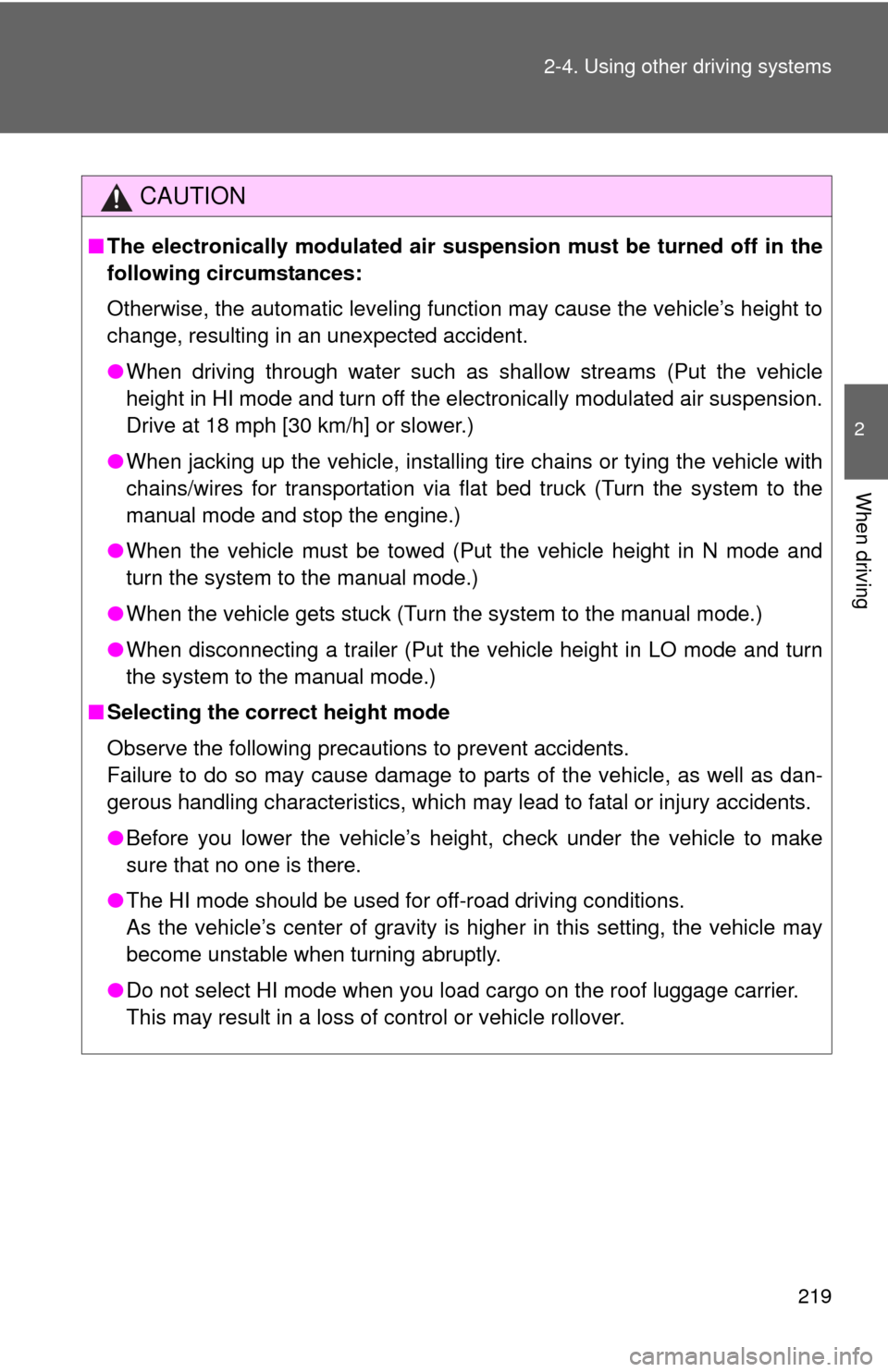
219
2-4. Using other
driving systems
2
When driving
CAUTION
■The electronically modulated air susp ension must be turned off in the
following circumstances:
Otherwise, the automatic leveling function may cause the vehicle’s height to
change, resulting in an unexpected accident.
● When driving through water such as shallow streams (Put the vehicle
height in HI mode and turn off the electronically modulated air suspension.
Drive at 18 mph [30 km/h] or slower.)
● When jacking up the vehicle, installing tire chains or tying the vehicle with
chains/wires for transportation via flat bed truck (Turn the system to the
manual mode and stop the engine.)
● When the vehicle must be towed (Put the vehicle height in N mode and
turn the system to the manual mode.)
● When the vehicle gets stuck (Turn the system to the manual mode.)
● When disconnecting a trailer (Put the vehicle height in LO mode and turn
the system to the manual mode.)
■ Selecting the correct height mode
Observe the following precautions to prevent accidents.
Failure to do so may cause damage to parts of the vehicle, as well as dan-
gerous handling characteristics, which may lead to fatal or injury accidents.
●Before you lower the vehicle’s height, check under the vehicle to make
sure that no one is there.
● The HI mode should be used for off-road driving conditions.
As the vehicle’s center of gravity is higher in this setting, the vehicle may
become unstable when turning abruptly.
● Do not select HI mode when you load cargo on the roof luggage carrier.
This may result in a loss of control or vehicle rollover.
Page 234 of 660
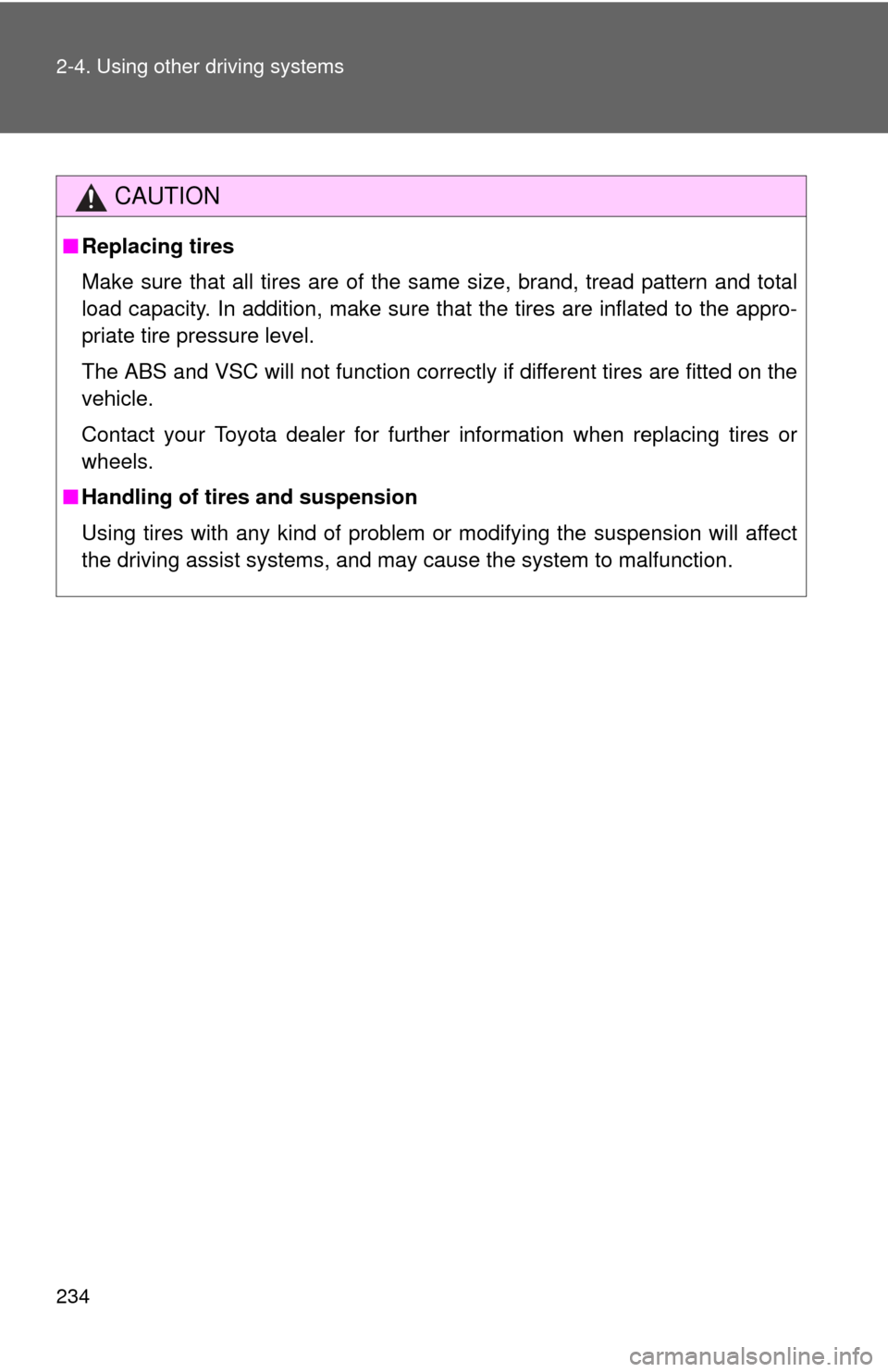
234 2-4. Using other driving systems
CAUTION
■Replacing tires
Make sure that all tires are of the same size, brand, tread pattern and total
load capacity. In addition, make sure that the tires are inflated to the appro-
priate tire pressure level.
The ABS and VSC will not function correctly if different tires are fitted on the
vehicle.
Contact your Toyota dealer for further information when replacing tires or
wheels.
■ Handling of tires and suspension
Using tires with any kind of problem or modifying the suspension will affect
the driving assist systems, and may cause the system to malfunction.
Page 260 of 660

260 2-5. Driving information
■Before towing
Check that the following conditions are met:
●Ensure that your vehicle’s tires are properly inflated. ( P. 615)
● Trailer tires should be inflated according to the trailer manufacturer’s rec-
ommendation.
● All trailer lights work to be legal.
● All lights work each time you connect them.
● The trailer ball is set up at the proper height for the coupler on the t\
railer.
● The vehicle remains level when a loaded or unloaded trailer is hitched.
Do not drive if the vehicle is not level, and check for improper tongue
load, overloading, worn suspension, or other possible causes.
● The trailer cargo is securely loaded.
● The rear view mirrors conform to all applicable federal, state/provincial or
local regulations. If they do not, install rear view mirrors appropriate for
towing purposes.
● Depress TOW/HAUL button (if equipped)
■ When connecting and disconnecting a trailer
Set the electronically modulated air suspension system to MAN., or turn off
the engine, when the system is in N mode. (if equipped)
■ AVS (adaptive variable suspension system) (if equipped)
The suspension can be switched for improvement in driveability. ( P. 221)
■ Break-in schedule
If your vehicle is new or equipped with any new power train components
(such as an engine, transmission, differential and wheel bearing), Toyota
recommends that you do not tow a trailer until it has been driven for over 500
miles (800 km).
However, avoid full throttle acceleration.
■ Maintenance
●If you tow a trailer, your vehicle will require more frequent maintenance
due to the additional load. (See “Scheduled Maintenance Guide” or
“Owner’s Manual Supplement”.)
● Retighten the fixing bolts of the towing ball and bracket after approxi-
mately 600 miles (1000 km).
Page 481 of 660
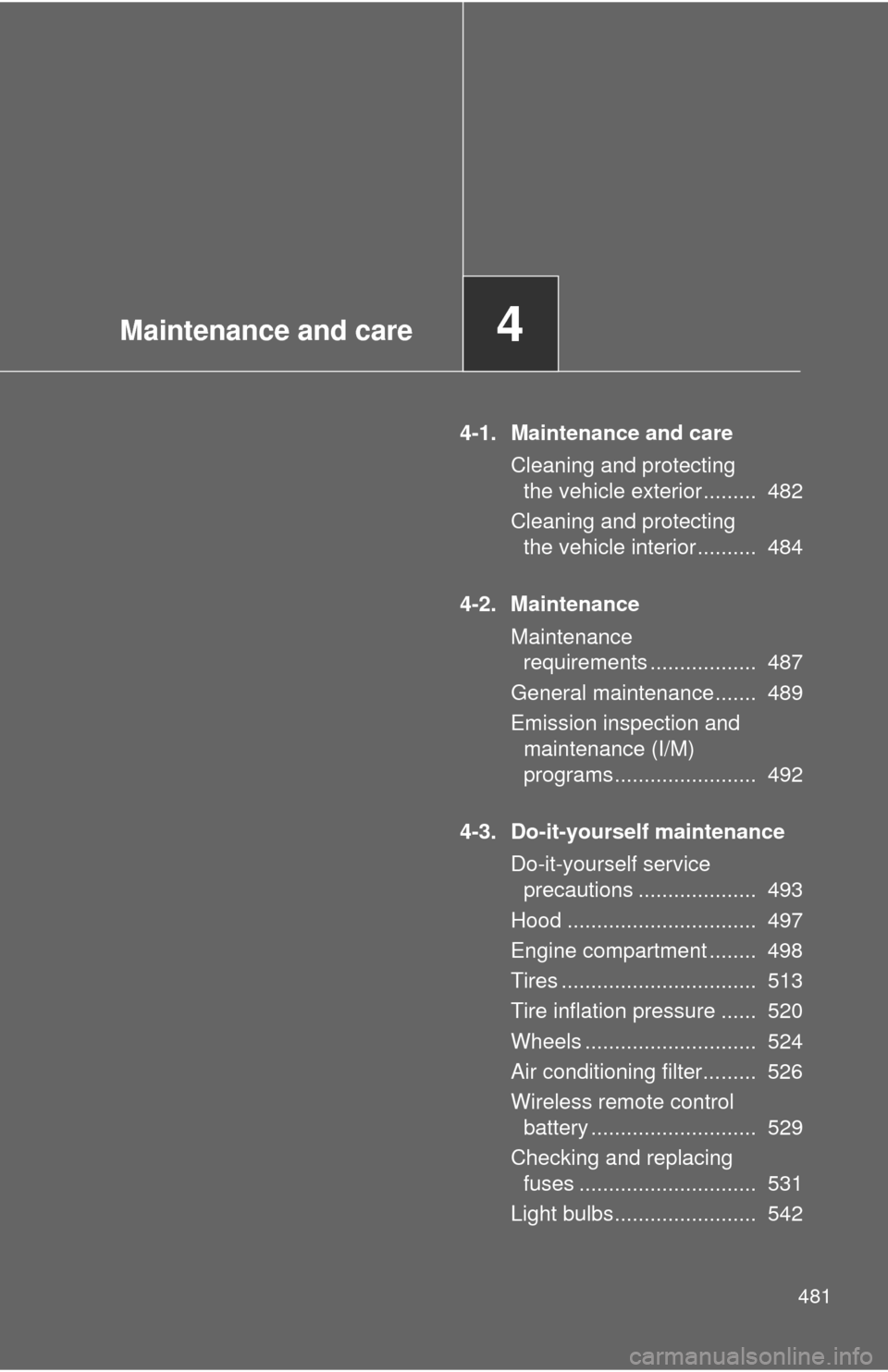
Maintenance and care4
481
4-1. Maintenance and careCleaning and protecting the vehicle exterior ......... 482
Cleaning and protecting the vehicle interior .......... 484
4-2. Maintenance Maintenance requirements .................. 487
General maintenance....... 489
Emission inspection and maintenance (I/M)
programs........................ 492
4-3. Do-it-yourself maintenance Do-it-yourself service precautions .................... 493
Hood ................................ 497
Engine compartment ........ 498
Tires ................................. 513
Tire inflation pressure ...... 520
Wheels ............................. 524
Air conditioning filter......... 526
Wireless remote control battery ............................ 529
Checking and replacing fuses .............................. 531
Light bulbs........................ 542
Page 491 of 660
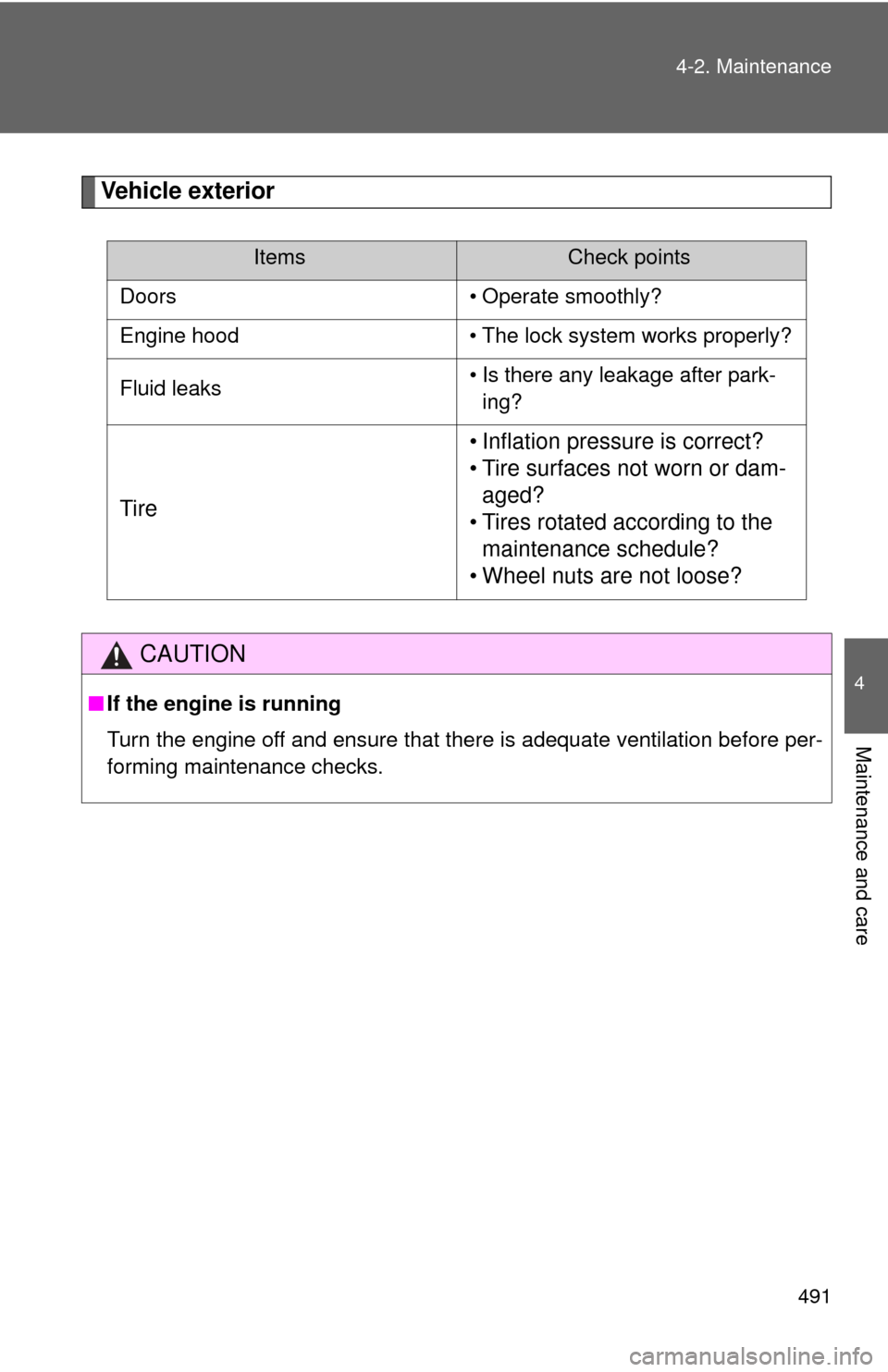
491
4-2. Maintenance
4
Maintenance and care
Vehicle exterior
ItemsCheck points
Doors • Operate smoothly?
Engine hood • The lock system works properly?
Fluid leaks • Is there any leakage after park-
ing?
Tire • Inflation pressure is correct?
• Tire surfaces not worn or dam-
aged?
• Tires rotated according to the maintenance schedule?
• Wheel nuts are not loose?
CAUTION
■ If the engine is running
Turn the engine off and ensure that there is adequate ventilation before per-
forming maintenance checks.